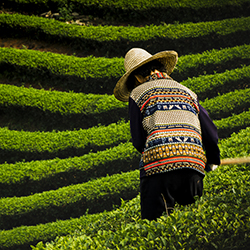
The Ground We Have in Common
documentary and contemporary art exhibition
| - |
|---|
| Gallerie delle Prigioni |
Fondazione Benetton and Gallerie delle Prigioni present an exhibition dedicated to the 30th edition of the International Carlo Scarpa Prize for Gardens, which this year is awarded to The Tea Gardens of Dazhangshan in China.
For the first time, the exhibition, which is part of a wider programme of events to celebrate the Prize, will add the language of contemporary arts to the research of the Prize committee.
Starting from an in-depth exploration of the Tea Gardens of Dazhangshan, the display highlights the cultural significance of tea as a drink, as well as the architectural and geographical contexts of this place, which throughout history has been one of the most important areas of green tea cultivation.
In Dazhangshan, over 250 families cultivate tea plants according to the principles of organic farming. In this way, those who make a living from the land maintain a close relationship with their environment, guaranteeing the continuity of cultural traditions, aesthetic values and an equilibrium between humanity and nature. These themes are also explored by the documentary specially produced for the Prize and directed by Davide Gambino, in collaboration with Gabriele Gismondi.
The Ground We Have in Common revisits ideas and themes that have traversed the previous editions of the Prize, bringing together artworks, archival material, texts, photographs, publications and films. It examines the languages chosen by contemporary artists who, starting from personal experiences and contexts, explore both the concept of the garden in a wider sense and that of taking care of the land.
A selection of artworks addresses broader themes relating to the Carlo Scarpa Prize through different artistic approaches. History and memory form a lens through which to examine the symbiotic relationship between humanity and our environment, raising questions of preservation and renewal. The research focuses on the role that trade and exchange – both interpersonal and international – have played in shaping how we experience our surroundings. Susan Hiller explores this concept in her sound work that references Mendel’s genetic theories, while Petros Efstathiadis’ photographs evoke a complex connection with his hometown that is both highly localised and universal.
The physicality of natural elements is another key theme – fruit, leaves, seeds, an integral part of Christiane Löhr’s sculptures; wood, which is the material employed by Michele Spanghero to perceive sound; and clay, as seen in a brand new commission by William Cobbing. These materials pay testimony to the manual and intellectual skills that are required both for the transformation of the landscape and for the transmission of this knowledge from a local to a global context.
Curators: Patrizia Boschiero and Nicolas Vamvouklis.
Artists: Antonio Biasiucci, Andrea Caretto & Raffaella Spagna, William Cobbing, Petros Efstathiadis, Susan Hiller, Christiane Löhr, Laura Pugno, Naufus Ramírez–Figueroa, Elham Rokni, Armén Rotch & Gilda RG, Michele Spanghero, Cao Yuxi (James).
